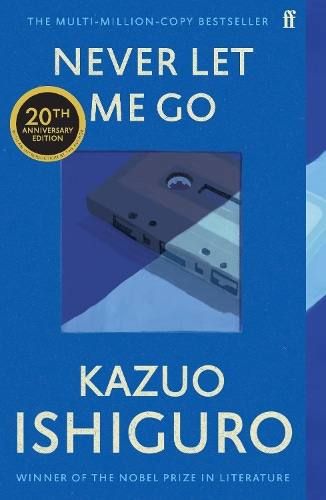Week Two of Never Let Me Go: "These incidents now feel full of significance"
On reminiscence creating significance and dread, and the midpoint reveal

Welcome to Week Two of reading Never Let Me Go in honor of its twentieth anniversary! You can read the Announcement, Kickoff, and Week One posts if you need to catch up.
A non-exhaustive recap of Chapters Five through Nine
A lot happens in these chapters! I’d forgotten how Ishiguro structures the novel, where we get one of the biggest reveals right there in Chapter Seven, slightly before the midway point, when Miss Lucy tells the Hailsham children that
Your lives are set out for you. You’ll become adults, then before you’re old, before you’re even middle-aged, you’ll start to donate your vital organs. That’s what each of you was created to do. You’re not like the actors you watch on your videos, you’re not even like me. You were brought into this world for a purpose, and your futures, all of them, have been decided.
(What I would give to be able to go back to my first reread and note down how it felt to experience this reveal for the first time.)
On reminiscence creating significance
So a little detour. I just got back my first edit letter on my debut novel, which I plan on writing about soon. In my novel, I use a few instances of framing to make it clear that an older, wiser version of my main character is narrating the story. My editor wrote that this device can “remind the reader of the ways seemingly small interactions or experiences can live on to become more impactful in its aftermath than ever seemed possible in the actual moment.”
In fact, she actually suggested I add it in more, particularly as the novel progresses:
You can use it to highlight moments of significant poignancy, or moments where bringing the narrative out of the adolescent gaze and into an adult one will emphasize the emotional power of a scene.
I’ve been thinking about this note all week. And I think Ishiguro does that in Never Let Me Go so beautifully.
Kathy constantly signals to us that this telling is the result of her having gone back over her life again and again, and how she’s picked out the moments that are significant to her now. In the beginning of Chapter Seven, for example, she notes that she thinks of the talk with Tommy by the pond “now as a kind of marker between the two eras” of her life at Hailsham. At another point, she says, “[I]f these incidents now seem full of significance and all of a piece, it’s probably because I’m looking at them in the light of what came later.”
I mean, every novel does this to some degree: authors or tellers choose what to leave in and what to leave out. There’s a reason that most novels don’t have endless scenes narrating characters going to the bathroom, or Swiffering their wood floors, or waiting in line at the DMV. But there’s something about the way that Ishiguro makes visible Kathy’s memory-sifting and significance-attaching—it gives us the sense that we are rereading Kathy’s life along with her.
That’s fitting, given that Ishiguro scholar Chris Holmes writes that reading Ishiguro always necessarily entails a kind of rereading, even if you’re picking up the book for the first time. (Spoilers in the hyperlink!)
On reminiscence creating dread
I hadn’t thought about it until I read Rachel Cusk explaining this concept, but this framing device also creates so much of the suspense in this novel. As Cusk writes, “the inescapable repetitions of reminiscence” act as a “dead hand approach,” creating “an atmosphere of unbearable constriction that is like looking back down a tunnel.”
I recently read Tana French’s novel In the Woods, which is very much a crime/murder-mystery novel, and she employs the same device. In that novel, the first-person narrator is a detective. As he tells us what happened in the investigation, he’ll tease that events or clues will turn out to be significant, but that he didn’t realize it at the time. (“I suppose you could say my real weakness is a kind of long-sightedness: usually it is only at a distance, and much too late, that I can see the pattern.”) And that creates a lot of suspense: we know that a detail will be important, but we don’t know how, and we’re just waiting for the penny to drop.
That also fits with what Ishiguro has said about how he was stuck on writing the novel until he met Alex Garland, who freely uses genre conventions in his work. Ishiguro reminds me, as a literary writer, that we can use writing techniques commonly seen in genres like sci-fi and crime to add greater depth and compulsion to our own work.1
On reminiscence and the midpoint reveal
Finally, one last note on Ishiguro’s Chapter-Seven reveal. (
recently wrote a great post about the midpoint revelation on her Substack!)To me, this is a perfect midpoint revelation in part because it really casts everything we’ve read before in a new light: it explains to the use of the terms “donors” and “carers” and “completion,” it adds depth to the guardians’ weird behavior, and gives us context for Hailsham’s focus on students’ health and anti-smoking and all that.
That’s fitting, given that Holmes says, “Reading Ishiguro thus means reading palimpsestically, feeling for traces of what came before.” He also quotes Vladimir Nabokov, who said that “one cannot read a book: one can only reread it.” That’s another reason I love this novel: it rewards careful reading and rereading, with so much richness every time you return to the text. (As Nabokov said, “a good reader, a major reader, an active and creative reader is a rereader”!)
It doesn’t explain everything, of course. For example, what did Miss Lucy mean by saying that Hailsham kids “were created”? What has become of Ruth and Tommy and Kathy’s relationships? What is Madame’s Gallery? Let’s see if we find out…
Extra-Credit Reading
I’ve been obsessed with this essay from Ishiguro scholars Chris Holmes and Kelly Mee Rich, “On Rereading Kazuo Ishiguro (contains spoilers). In particular, I’ve been thinking a lot about his summary of how various scholars discuss Kathy H.’s narration style, which ties so perfectly into the Week One post:
Thom Dancer writes about how the first-person narration deprives us, the reader, of any clear “authoritative narrative presence” that might “guide us toward the
correct ethical or political choice” regarding Kathy’s situation. Through the narration, we have to “withhold externalized judgement and to make the empathetic leap to see the world through Kathy’s eyes.”
Adam Parkes writes about how Kathy’s voice is kind of dull: “If we find it hard to stay with Kathy, if we find her language and storytelling style not merely plain but dull, dull even to the point of wanting to put the book down, are we not encountering the limits of our sympathy as readers and perhaps as human beings?”
The Remains of the Schedule
Week Three (Tuesday, May 27 to Monday, June 2): Chapters Ten through Seventeen, ending at Part Three
Week Four (Tuesday, June 3 to Monday, June 10): Chapters Eighteen through the end
My current work-in-progress is a crime novel, and you can bet that I am stealing this device.








I'm very curious about what Miss Lucy called, "terrible accidents!" I'm guessing that it's going to be significant and terrible!
I'm also wondering why Kathy describes some of the relationships and past events in such seemingly small details when, to me as a 1st-time listener, they don't seem very significant. Will those details be significant looking back?
Thanks for the mention. Glad my articled tied in :)